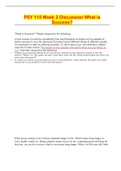Samenvatting
Summary Human and Animal Biology II
- Instelling
- Wageningen University (WUR)
This is a summary of the lectures from the course Human and Animal Biology 2 (now called Human and Animal Physiology), and a summary of the books "Integrated principles of zoology" 17th edition from Hickman et al., and "Principles of human physiology" 6th edition from Stanfield.
[Meer zien]













